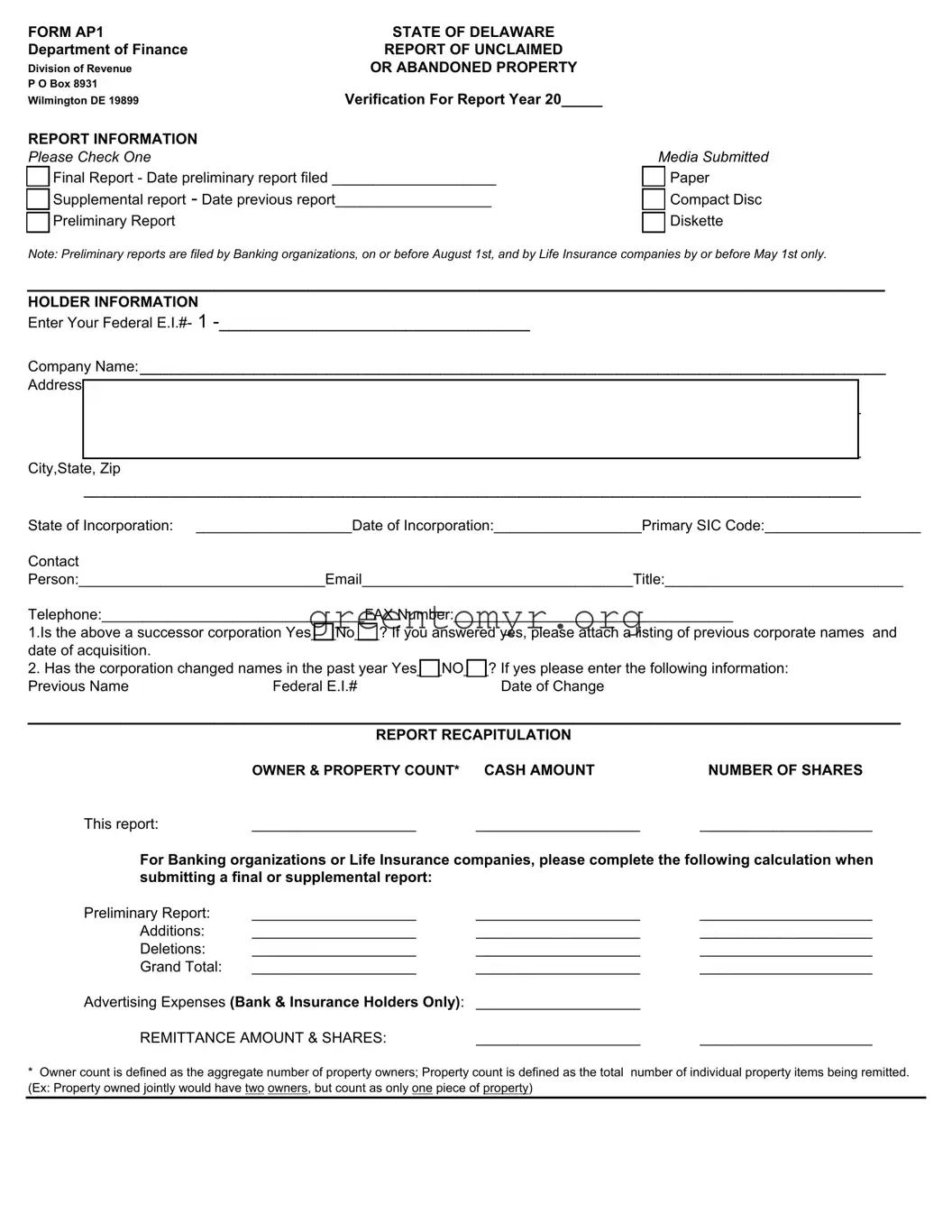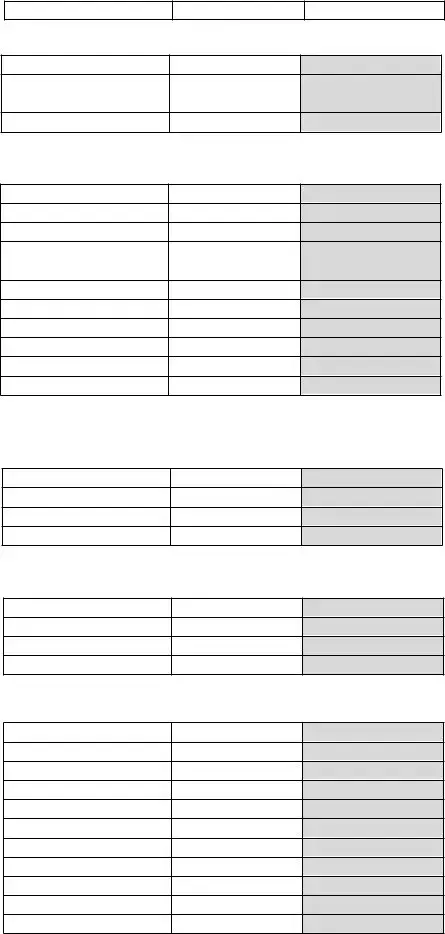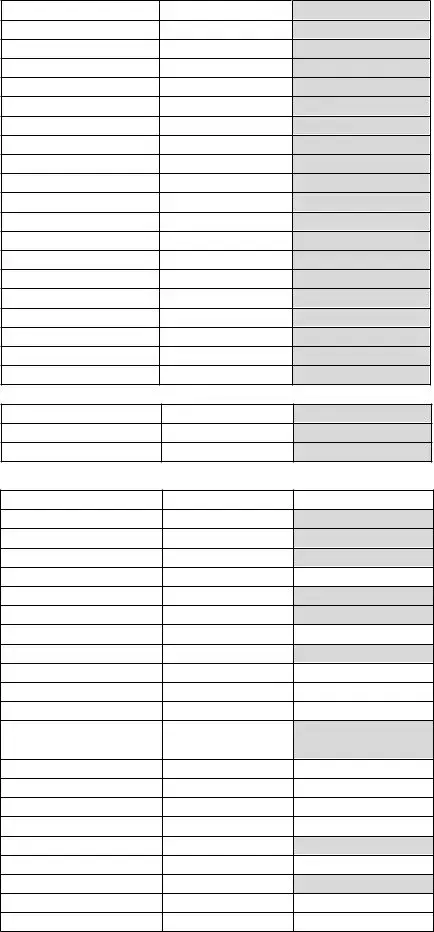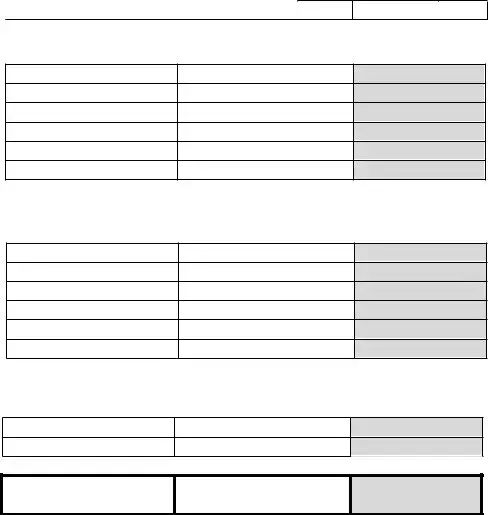FORM AP1 |
STATE OF DELAWARE |
Department of Finance |
REPORT OF UNCLAIMED |
Division of Revenue |
OR ABANDONED PROPERTY |
P O Box 8931 |
|
Wilmington DE 19899 |
Verification For Report Year 20_____ |
REPORT INFORMATION
Please Check One
[] Final Report - Date preliminary report filed ____________________
[] Supplemental report - Date previous report___________________
[] Preliminary Report
Media Submitted
[] Paper
[] Compact Disc
[] Diskette
Note: Preliminary reports are filed by Banking organizations, on or before August 1st, and by Life Insurance companies by or before May 1st only.
_______________________________________________________
HOLDER INFORMATION
Enter Your Federal E.I.#- 1 -______________________________
Company Name:________________________________________________________________________
Address:
___________________________________________________________________________
___________________________________________________________________________
City,State, Zip
___________________________________________________________________________
State of Incorporation: ___________________Date of Incorporation:__________________Primary SIC Code:___________________
Contact
Person:______________________________Email_________________________________Title:_____________________________
Telephone:________________________________FAX Number:__________________________________
1.Is the above a successor corporation Yes___No___? If you answered yes, please attach a listing of previous corporate names and date of acquisition.
2. Has the corporation changed names in the past year Yes___NO___? If yes please enter the following information:
Previous NameFederal E.I.#Date of Change
________________________________________________________
|
REPORT RECAPITULATION |
|
|
OWNER & PROPERTY COUNT* |
CASH AMOUNT |
NUMBER OF SHARES |
This report: |
____________________ |
____________________ |
_____________________ |
For Banking organizations or Life Insurance companies, please complete the following calculation when |
submitting a final or supplemental report: |
|
|
Preliminary Report: |
____________________ |
____________________ |
_____________________ |
Additions: |
____________________ |
____________________ |
_____________________ |
Deletions: |
____________________ |
____________________ |
_____________________ |
Grand Total: |
____________________ |
____________________ |
_____________________ |
Advertising Expenses (Bank & Insurance Holders Only): ____________________ |
|
REMITTANCE AMOUNT & SHARES: |
____________________ |
_____________________ |
*Owner count is defined as the aggregate number of property owners; Property count is defined as the total number of individual property items being remitted. (Ex: Property owned jointly would have two owners, but count as only one piece of property)
FORM AP1 |
STATE OF DELAWARE |
Department of Finance |
REPORT OF UNCLAIMED |
Division of Revenue |
OR ABANDONED PROPERTY |
P O Box 8931 |
|
Wilmington DE 19899 |
Verification For Report Year 20_____ |
HOLDER DELIVERY OF SECURITIES:
Holders delivering securities must provide account statements and documentation related to the State of Delaware Escheatment. Have securities been transferred to the State account: ______Yes ______ No
Are account statements and transfer documentation included with this report: ______Yes ______ No
_____________________________________________________________________________________
VERIFICATION
State of_________________________:
County of________________________: ss
I, ________________________________________ being first duly sworn, on oath depose and state that I have caused to be prepared and have
examined this report as to property presumed abandoned under the Delaware Unclaimed Property Law for the year ending as stated; that I am duly authorized by the holder to execute this report; and I believe that said report is true, correct and complete as of said date, excepting for such property as has ceased to be abandoned.
Signature__________________________________ Title________________________________________
Subscribed and sworn to before me this____________day of__________, 20_________.
DOCUMENT NO: 25-06/87/11/10
AP-1 CHECKLIST
# OWNERS / # PROP. |
$ REPORTED |
# SHARES |
ACCOUNT BALANCES
AC01 Checking Accounts
AC02 Savings Accounts
AC03 Matured CD or Savings Certs.
AC04 Christmas Club Accounts
AC05 Money on Deposit to Secure Funds
AC06 Security Deposits
AC07 Unidentified Deposits
AC08 Suspense Accounts
AC99 Aggregate
TOTAL
UNCASHED CHECKS
CK01 Cashiers Checks
CK02 Certified Checks
CK03 Registered Checks
CK04 Treasurers Checks
CK05 Drafts
CK06 Warrants
CK07 Money Orders
CK08 Travelers Checks
CK09 Foreign Exchange Checks
CK10 Expense Checks
CK11 Pension Checks
CK12 Credit Checks or Memos
CK13 Vendor Checks
CK14 Checks Written off to Income
CK15 Other Official Checks
CK16 CD Interest Checks
CK99 Aggregate
TOTAL
COURT DEPOSITS
CT01 Escrow Funds
CT02 Condemnation Awards
CT03 Missing Heirs’ Fund
CT04 Suspense Accounts
CT05 Other Court Deposits
CT99 Aggregate
TOTAL
EDUCATIONAL SAVINGS ACCOUNTS
CS01 Cash
CS02 Mutual Funds
CS03 Securities
TOTAL
AP-1 CHECKLIST - CONTINUED
# OWNERS / # PROP.
HEALTH SAVINGS PLAN
HS01 Health Savings Account
HS02 Health Savings Account
Investment
TOTAL
INSURANCE
IN01 Indiv. Policy Benefits or Claims
IN02 Group Policy Benefits or Claims
IN03 Proceeds Due Beneficiaries
IN04 Proceeds From Matured Policies,
Endowments or Annuities
IN05 Premium Refunds
IN06 Unidentified Remittances
IN07 Other Amounts Due Under Policy
IN08 Agent Credit Balances
IN99 Aggregate
TOTAL
IRA - TRADITIONAL, SEP, SARSEP, AND SIMPLE
IR01 Cash
IR02 Mutual Funds
IR03 Securities
TOTAL
IRA - ROTH
IR05 Cash
IR06 Mutual Funds
IR07 Securities
TOTAL
MINERAL PROCEEDS & INTERESTS
MI01 Net Revenue Interest
MI02 Royalties
MI03 Overriding Royalties
MI04 Production Payments
MI05 Working Interest
MI06 Bonuses
MI07 Delay Rentals
MI08 Shut-in Royalties
MI09 Minimum Royalties
MI99 Aggregate
TOTAL
Funds for Liquadition/Redemption
(Accounts Rec.)
AP-1 CHECKLIST - CONCLUDED
# OWNERS / #PROP. |
$ REPORTED |
# SHARES |
|
|
|
MISC. CHECKS & INTANGIBLE PERSONAL PROPERTY
MS01 Wages, Payroll, Salary
MS02 Commissions
MS03 Workers Compensation Benefits
MS04 Payment for Goods & Services
MS05 Customer Overpayments
MS06 Unidentified Remittances
MS07 Unrefunded Overcharges
MS08 Accounts Payable
MS09 Credit Balances
MS10 Discounts Due
MS11 Refunds Due
MS12 Unredeemed Gift Certificates
MS13 Unclaimed Loan Collateral
MS14 Pension & Profit Sharing Plans
MS15 Dissolution or Liquidation
MS16 Misc Outstanding Checks
MS17 Misc Intangible Property
MS18 Suspense Liabilities
MS99 Aggregate
TOTAL
SAFE DEPOSIT BOX (SAFEKEEPING)
SD01 SD Box Net Proceeds
SD02 Other Safekeeping
TOTAL
SECURITIES
SC01 Dividends
SC02 Interest (Bond Coupons)
SC03 Principal Payments
SC04 Equity Payments
SC05 Profits
SC06 Funds to Purchase Shares
SC07 Funds for Stocks & Bonds
SC08 Shares of Stock (Returned by P.O.)
SC09 Cash For Fractional Shares
SC10 Unexchanged Shares of Successor Corp
SC11 Other Certs. of Ownership
SC12 Underlying Shares
SC13
of unsurrendered Stock or bonds
SC14 Debentures
SC15 US Government Securities
SC16 Mutual Fund Shares
SC17 Warrants (Rights)
SC18 Matured Bond Principal
SC19 Dividend Reinvestment Plans
SC20 Credit Balances
SC99 Aggregate
TOTAL
AP-1 CHECKLIST - CONCLUDED
|
|
|
# OWNERS / #PROP. |
$ REPORTED |
|
|
|
TRUST, INVESTMENT & ESCROW ACCOUNTS
TR01 Paying Agent Accounts
TR02 Undelivered or Uncashed Dividends
TR03 Funds Held In Fiduciary Capacity
TR04 Escrow Accounts
TR05 Trust Vouchers
TOTAL
UTILITIES
UT01 Utility Deposits
UT02 Membership Fees
UT03 Refunds or Rebates
UT04 Capital Credit Distributions
UT99 Aggregate
TOTAL
ALL OTHER PROPERTY NOT IDENTIFIED ABOVE
ZZZZ ALL OTHER PROPERTY
TOTAL
GRAND TOTAL *
* Please total all property categories and enter grand total on front of form AP-1 in the Report Recapitulation section.






